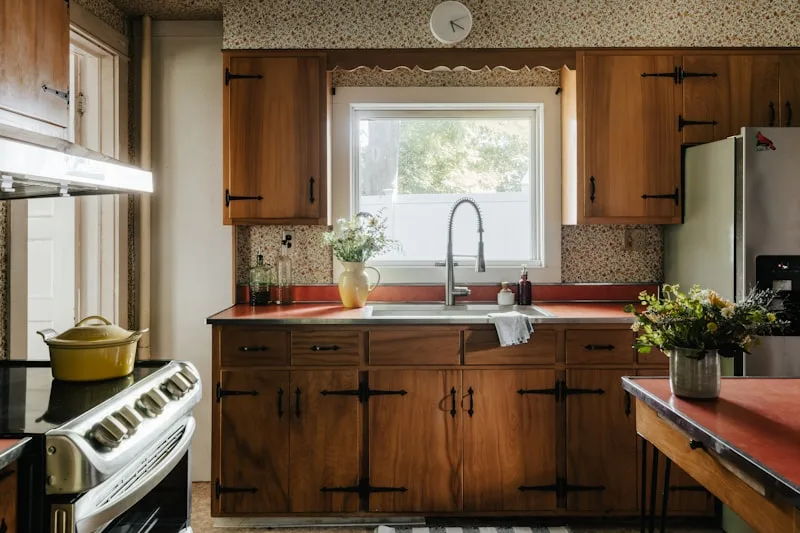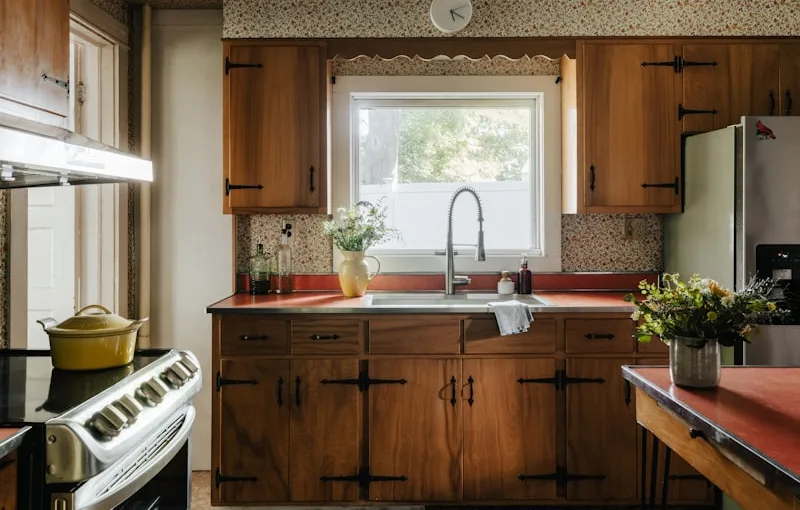
First things first, gather your supplies. You’ll need a good quality paint stripper, some old rags, a putty knife, and safety gear like gloves and goggles. Think of the paint stripper as your magic potion—it’s going to help dissolve that old paint like butter on a hot skillet.
Once you’ve got your gear on, apply the paint stripper generously to a small section of your cabinet. Let it sit for a few minutes—this is where the magic happens! You’ll see the paint start to bubble and lift away. It’s like watching a caterpillar transform into a butterfly, revealing the beautiful wood underneath.
Now, grab your putty knife and gently scrape away the softened paint. Be careful not to gouge the wood; you want to reveal its natural beauty, not create a horror story! If you encounter stubborn spots, don’t hesitate to apply more stripper and give it another go.
After you’ve stripped all the paint, it’s time for a good clean-up. Use a damp rag to wipe away any residue from the stripper. This step is crucial because you want a clean surface for your new finish.
And there you have it! Your cabinets are now stripped and ready for their next chapter. Just think of the possibilities—new colors, stains, or even a chic distressed look. The world is your oyster, and your kitchen is about to get a fabulous makeover!
Revive Your Kitchen: A Step-by-Step Guide to Stripping Painted Cabinets
First things first, gather your supplies. You’ll need a good quality paint stripper, some old rags, a putty knife, and safety gear like gloves and goggles. Think of the paint stripper as your magic potion—it’s going to help you peel away those layers of paint like an onion!
Once you’re geared up, start by removing the cabinet doors and hardware. This is like giving your cabinets a spa day; they’ll appreciate the extra attention. Apply the paint stripper generously, following the manufacturer’s instructions. Let it sit for a while—this is the part where you can grab a cup of coffee and admire your work in progress.
After the stripper has done its job, use the putty knife to gently scrape off the paint. It’s like peeling a sunburn, but way more satisfying! If you encounter stubborn spots, don’t hesitate to reapply the stripper.
Once you’ve stripped away the old paint, give your cabinets a good wash with soap and water to remove any residue. This is the refreshing shower they’ve been waiting for! Finally, sand the surfaces lightly to prepare them for a new finish.
Now, you’re ready to either stain or repaint your cabinets, giving them a brand-new life. Just think about how amazing it’ll feel to walk into your kitchen and see those beautifully revived cabinets shining back at you!
From Drab to Fab: Transform Your Kitchen with These Cabinet Stripping Techniques
First off, let’s talk about the magic of stripping. No, not that kind! We’re talking about removing old paint or stain to reveal the beautiful wood underneath. It’s like peeling an onion—each layer brings you closer to the juicy goodness inside. You can use chemical strippers, which are super effective but require some safety precautions, or go the eco-friendly route with heat guns or sanding. Just imagine the satisfaction of watching that old finish bubble up and peel away!
Once you’ve stripped those cabinets down to their bare bones, it’s time to get creative. Think of this as your blank canvas. You could go for a classic stain that highlights the natural grain of the wood, or maybe a bold paint color that screams personality. Ever thought about a two-tone look? It’s like giving your cabinets a stylish haircut—fresh, modern, and oh-so-chic!
And don’t forget about the hardware! Swapping out old knobs and handles for something trendy can make a world of difference. It’s like adding the perfect accessory to an outfit; suddenly, everything just clicks.
DIY Delight: How to Effectively Strip Paint from Your Kitchen Cabinets
First things first, let’s talk about the tools you’ll need. Grab some paint stripper, a putty knife, and a few rags. Think of the paint stripper as your magic potion—it’s going to do the heavy lifting for you. Apply it generously to the cabinet surface, and watch as it starts to bubble and lift the old paint. It’s like watching a caterpillar transform into a butterfly, only in reverse!
Now, here’s where the putty knife comes in. Gently scrape away the softened paint, almost like peeling a sunburn. Be careful not to gouge the wood underneath; you want to reveal the beauty beneath, not create a new problem. If you hit a stubborn spot, don’t fret! Just reapply the stripper and give it a little more time to work its magic.
Once you’ve stripped away the old paint, it’s time to clean up. Use a rag dampened with mineral spirits to wipe down the cabinets. This step is crucial—it’s like giving your cabinets a refreshing shower after a long day.
Finally, let everything dry completely before you think about painting or staining. This is your moment to shine, so take your time! With a little patience and creativity, your kitchen cabinets will be the talk of the town, and you’ll feel like a DIY superstar. Who knew stripping paint could be this much fun?
Unlock the Beauty Beneath: Expert Tips for Stripping Painted Kitchen Cabinets
First off, safety is key. Grab some gloves and a mask because those paint strippers can be pretty potent. Think of it as gearing up for a mini adventure—protecting yourself is half the fun! Next, choose the right stripper. There are gel, liquid, and even eco-friendly options. Gel strippers cling to vertical surfaces, making them perfect for cabinets. It’s like having a trusty sidekick that won’t let you down!
Now, let’s talk technique. Apply the stripper generously and let it sit for the recommended time. This is where patience pays off. Imagine waiting for a cake to bake; you can’t rush perfection! Once the time’s up, use a putty knife to gently scrape away the paint. It’s satisfying, like peeling a sunburn—just way less painful!
After you’ve stripped the paint, you’ll want to clean the surface. A little mineral spirits on a rag will do wonders, removing any residue and prepping the wood for its big reveal. Think of it as giving your cabinets a refreshing shower before their grand debut!
Finally, don’t forget to sand the cabinets lightly. This step is like giving them a spa treatment, smoothing out any rough edges and ensuring they’re ready for a fresh coat of stain or paint. With these expert tips, you’ll unlock the beauty beneath and transform your kitchen into a stunning space that reflects your style!
Frequently Asked Questions
What products are recommended for stripping paint effectively?
For effective paint stripping, consider using products like methylene chloride-based strippers, which work quickly on multiple layers, or safer alternatives like soy-based or citrus-based strippers that are less toxic. Always follow safety guidelines and test on a small area first.
What are the best methods for stripping paint from kitchen cabinets?
To effectively remove paint from kitchen cabinets, consider using methods such as chemical paint strippers, which dissolve paint for easy removal, or heat guns that soften the paint for scraping. Sanding is another option, though it requires careful technique to avoid damaging the wood. Always ensure proper ventilation and safety measures when using chemicals or heat.
How long does it take to strip paint from kitchen cabinets?
The time required to strip paint from kitchen cabinets varies based on the method used and the number of cabinets. Generally, it can take anywhere from a few hours to a couple of days. Chemical strippers may require several applications and drying time, while sanding can be quicker but more labor-intensive. Proper preparation and technique can significantly affect the overall duration.
What safety precautions should I take when stripping paint?
When stripping paint, ensure proper ventilation by working in an open area or using fans. Wear protective gear, including gloves, goggles, and a mask to avoid inhaling harmful chemicals. Keep flammable materials away from the work area and use drop cloths to protect surfaces. Follow the manufacturer’s instructions for the paint stripper and dispose of waste materials safely.
How do I prepare my kitchen cabinets for paint stripping?
To prepare your kitchen cabinets for paint stripping, start by removing all hardware, including knobs and hinges. Clean the surfaces thoroughly to eliminate grease and dirt. Use a screwdriver to take off the cabinet doors and drawers for easier access. Sand the surfaces lightly to help the stripper adhere better. Finally, ensure the area is well-ventilated and protect surrounding surfaces with drop cloths.
